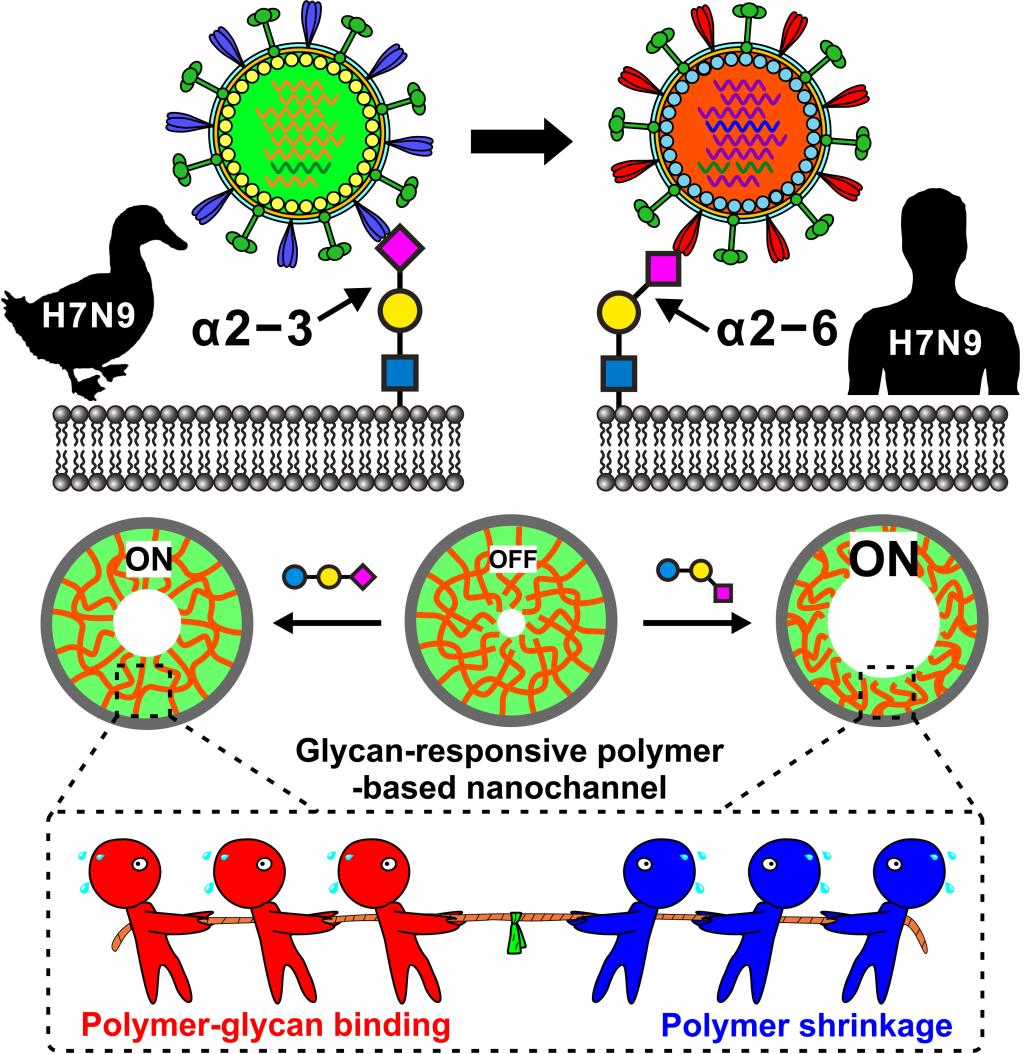我组李闵闵博士(生物分离与界面分子机制创新特区研究组,18T7),在仿生离子通道用于唾液酸糖链识别与区分方面取得进展,相关成果以Edge Article形式发表在英国皇家化学会《化学科学》(Chemical Science)(DOI:10.1039/c9sc05319k)杂志上。
唾液酸糖通常以α2-3或α2-6方式连接在糖链末端,组成了哺乳动物细胞或一些分泌蛋白质表面丰富的唾液酸糖链分布,这种最外端位置及其广泛的分布性使得唾液酸糖链在病毒感染、免疫响应、癌症发展等过程中起着重要作用。然而,唾液酸糖链组成复杂,连接形式多样,甚至存在连接异构体,这极大地增加了识别鉴定或结构解析的难度。
李闵闵和熊雨婷博士将具有糖识别响应性的聚合物接枝到纳米通道内部,利用不同糖链诱导聚合物收缩,从而导致纳米通道不同程度的“OFF‒ON”变化,以及输出离子电流的可识别变化,实现不同糖链链接异构体的识别与区分。这一工作进一步拓展了仿生离子通道器件在生物分子识别传感中的应用,尤其是在复杂糖链分子的识别和结构解析方面做了探索,为后续实现复杂糖链单分子识别与解析做了铺垫。
同时研究组还利用智能聚合物的设计理念,实现了钙离子自调控的仿生离子通道的构建(NPG Asia Materials, 2019, 11, 46)以及环磷酸腺苷调控的纳米离子通道(J. Mater. B. 2019, 7, 3710)。
这些研究得到了国家自然科学基金面上项目、化物所创新特区组启动基金等项目的支持。同时,该工作也是献礼我所七十周年所庆文章之一。
Biomimetic nanochannels for the discrimination of sialylated glycans via a tug-of-war between glycan binding and polymer shrinkage
Minmin Li,Yuting Xiong,Dongdong Wang,Yunhai Liu,Bing Na,Haijuan Qin,Jinxuan Liu,Xinmiao Liang *and Guangyan Qing *
Chem. Sci., 2020, 11, 748.
DOI: 10.1039/c9sc05319k

Sialylated glycans that are attached to cell surface mediate diverse cellular processes such as immune responses, pathogen binding, and cancer progression. Precise determination of sialylated glycans,particularly their linkage isomers that can trigger distinct biological events and are indicative of different cancer types, remains a challenge, due to their complicated composition and limited structural differences. Here, we present a biomimetic nanochannels system integrated with the responsive polymer polyethyleneimine-g-glucopyranoside (Glc-PEI) to solve this problem. By using a dramatic “OFF–ON”change in ion flux, the nanochannels system achieves specific recognition for N-acetylneuraminic acid (Neu5Ac, the predominant form of sialic acid) from various monosaccharides and sialic acid species.Importantly, different “OFF–ON” ratios of the conical nanochannels system allows the precise and sensitive discrimination of sialylated glycan linkage isomers, a2–3 and a2–6 linkage (the corresponding ion conductance increase ratios are 96.2% and 264%, respectively). Analyses revealed an unusual tug-of-war mechanism between polymer-glycan binding and polymer shrinkage. The low binding affinity of Glc-PEI for the a2–6-linked glycan caused considerable shrinkage of Glc-PEI layer, but the high affinity for the a2–3-linked glycan resulted in only a slight shrinkage. This competition mechanism provides a simple and versatile materials design principle for recognition or sensing systems that involve negatively charged target biomolecules. Furthermore, this work broadens the application of nanochannel systems in bioanalysis and biosensing, and opens a new route to glycan analysis that could help to uncover the mysterious and wonderful glycoworld.
Footnotes
Dedicated to the 70th anniversary of Dalian Institute of Chemical Physics, CAS.